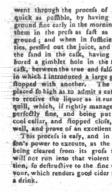[ An Approved Method of Making Cider ] Mr. Clifford
Date: 1791/05/04
Source:
Nova Scotia Magazine
Institution: Nova Scotia Archives
| Source Origin: Nova Scotia Newspapers on Microfilm
| Reference: Microfilm Reels 8062, 8063
Instructions for filtering out impurities when pressing cider. nn.291_92. Microfilm Reel 8063.
AN APPROVED METHOD OF MAKING CIDER.
[Communicated to the Burlington Agricultural Society, by Mr. Clifford]
TAKE care to have every necessary
utensil to be made use of in the
whole process, perfectly clean, and free
from every foreign smell. For this pur-
pose, before you begin your work, let your
mill, trough, and press, be made perfectly
clean, by thoroughly washing, and if ne-
cessary with scalding water. The casks
are another material object, and if musty,
or any other bad smell, one head should
be taken out, and with shavings or dry
brush, burn the inside; then scrub them
clean, and put in the head; scald them
well afterwards, and drain them perfectly;
when dry, bung them tight, and keep
them in a cool shady place, until wanted
for use.
The apples should be ripe; and all the
unripe and rotten ones, leaves, and every
other thing that can tend to give the ci-
der any disgreeable taste, carefully sepa-
rated from them.
I have found from careful attention and
many experiments, that it is a great ad-
vantage to the cider to be separated from
___
the gross parts as soon as possible; for
this purpose I tried several methods. That
which I found succeeded the best, I shall
now relate, as by following it, I was able
to preserve my cider in a sound state,
though made in the early part of the sea-
son.
I took a large pipe, of about 150 gal-
lons, had one of the heads taken out, and
on the inside of the other laid on
four strips of boards, two inches wide,
and on these strips placed a false bottom,
filled with gimblet holes about three inches
apart. On this false bottom I put a
piece of hair cloth (old blanket, or even
swingling tow will do,) so as to prevent
any sand from washing into the space be-
tween the true and false bottoms. I pro-
cured a quantity of coarse sand, which
was carefully washed in repeated waters,
till it would not discolour the clean water,
then dried the sand, and put it in the cask
on the hair cloth, blanket, or tow, about
nine inches thick.
Thus having every thing in readiness, I
went through the process of making, as
quick as possible, by having the apples
ground fine early in the morning, putting
them in the press as fast as they were
ground; and when in sufficient quanti-
ties, pressed out the juice, and put it over
the sand in the cask, having previously
bored a gimblet hole in the side of the
cask, between the true and false bottoms,
in which I introduced a large goose-quill,
stopped with another. The pipe was
placed so high as to admit a cask under it,
to receive the liquor as it run from the
quill, which, if rightly managed, will be
perfectly fine, and being put away in a
cool cellar, and stopped close, will keep
well, and prove of an excellent quality.
This process is easy, and in every per-
son’s power to execute, as the liquor, by
being cleared from its gross feculences,
will not run into that violent fermenta-
tion, so destructive to the fine vinous fla-
vour, which renders good cider so pleasing
a drink.
Download: Transcription | Images

